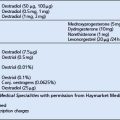CHAPTER 4 UROLOGY
URINARY TRACT INFECTION (UTI)
Diagnosis
Examination.
Examination is usually unnecessary, but look for suprapubic or loin tenderness, if appropriate.
Management
Management of recurrent UTIs in women
PROTEINURIA
URINARY STONES
Diagnosis
URINARY INCONTINENCE
Incontinence is involuntary leakage of urine and is a common and disabling condition. It is estimated that as many as 60% of the elderly population and 40% of women over the age of 20 suffer from some form of urinary incontinence. It can be significantly improved by appropriate intervention, but is underdiagnosed because a large percentage of sufferers do not consult their doctor. Stress incontinence and urge incontinence are responsible for over 90% of cases of incontinence. The two often coexist, but the most useful distinguishing factor is the absence of urgency in stress incontinence.
Diagnosis
History.
It is important to take advantage of routine screening opportunities to identify sufferers.
Management
Most patients can be treated satisfactorily by the GP.
Stress incontinence.
(due to weakness of the urethral sphincter.)




